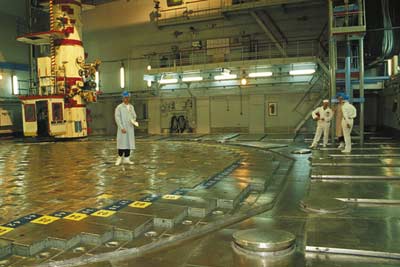Danish - Lithuanian Environmental Co-operation 1991-2000
Chapter 9
The closure of the ignalina nuclear power plant
In 1999 the Lithuanian parliament adopted a new national energy strategy encompassing the gradual closure of the Ignalina Nuclear Power Plant. Denmark very much applauds this decision, because of the intrinsic environmental risk of this kind of nuclear reactor. From the Danish side it is however at the same time recognised that the closure of Ignalina NPP - at any time - will impose a large economic impact on Lithuania. Substantial financial and technical support is therefore needed from the donor countries to implement the decision taken by the Lithuanian Government and Parliament
The Ignalina Nuclear Power Plant in northeastern Lithuania is a reactor of the same type (RBM) as the Chernobyl reactor in Ukraine, and as such the NPP causes a high health and environmental risk. Consequently, there has been a strong drive - not least from the international society - to decommission the plant.
In the autumn of 1999 the Lithuanian Parliament adopted a revised energy strategy encompassing a gradual closure and decommissioning of the Ignalina NPP.
The final decision in Lithuania on the future of Ignalina NPP has been a long and difficult process, due to the present low costs of electricity from Ignalina NPP and the very high decommissioning costs. The decision taken in 1999 is therefore an important decision for both Lithuania and the Baltic region. It is also a decision with unsolved financial and economic questions as Lithuania will not be able to bear the full costs of the legacy from the Soviet time; the Western European countries are needed both for financial and technical assistance.
The Danish assistance
In June 2000 the first Donor Conference on the Ignalina NPP decommissioning was held in Vilnius. A very large number of countries participated and pledged a total sum of more than DKK 1.487 million (EUR 200 million) for the decommissioning and derived areas.
The pledged amount from the Danish side will mainly be allocated on a bilateral basis in close co-operation between the Energy Sector Programme, the DANCEE programme and the counterparts of these programmes in Lithuania ( presently Ministry of Economy / Energy Agency and Ministry of Environmental Protection).
The Danish assistance is primarily targeted at reducing the economical impact of the closure of Ignalina NPP through energy efficiency, and the development of an environmental sustainable replacement of Ignalina NPP.
The main focus of the assistance will be :
| Energy savings (reduction of energy costs for industries and households), | |
| continued support to restructuring and efficiency improvements in district heating, as a precondition for new combined heat and power plants in Lithuania, | |
| investment grant for a new demonstration plant for combined heat and power production, | |
| institutional development of the Ministry of Economy and Energy Agency in drafting | |
| implementing an Action Plan for the National Energy Strategy, as well as support to the overall energy sector reform |
The total assistance for these purposes amounts to a total of DKK 100 million (EUR 13.45 million).
To support the actual decommissioning process, Denmark has pledged an amount to the Ignalina International Decommissioning Support Fund, to be established and administrated by the EBRD with a major contribution from the EU. A first contribution to this fund is approximately DKK 20 million (EUR 2.69 million).
The Danish pledge is scheduled for 2000- 2002.
Additionally Denmark will consider financial and technical support to mitigate the social problems deriving from the decommissioning.

Inside of the Ignalina Nuclear Power Plant.